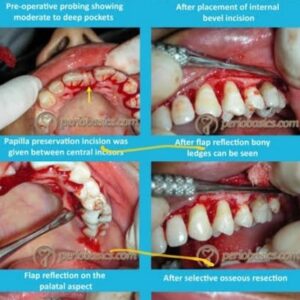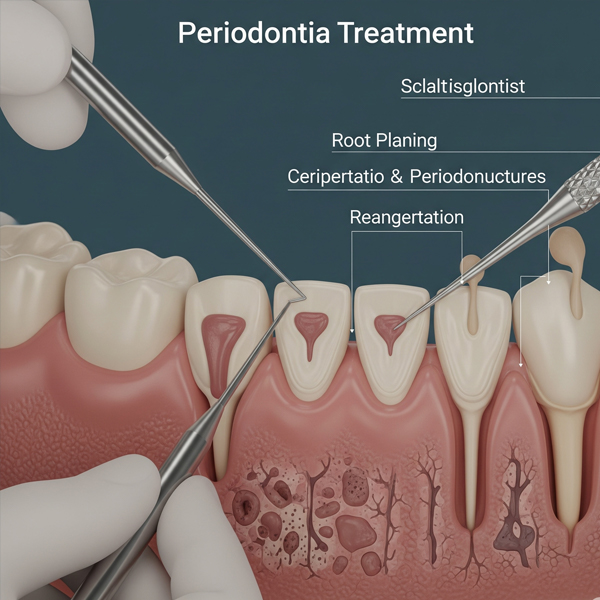Periodontia
Periodontal disease attacks the gums and bone surrounding your teeth resulting in gum swelling, infection, and potential bone, gum, and tooth loss. Periodontal disease is most often from improper oral care and irregular or non existent dental care by a dental professional.
Gum Disease Symptoms
- Red, swollen, or tender gums or other pain in your mouth.
- Bleeding while brushing, flossing, or eating hard food.
- Gums that are receding or pulling away from the teeth.
- Pus between your gums and teeth.
- Sores in your mouth.
- Persistent bad breath.
- A change in the way your teeth fit together when bite and fit in partial denture.
Gum Disease Types
Gingivitis
Gingivitis is the mildest form of periodontal disease. It causes the gums to become red, swollen, and bleed easily. There is usually little or no discomfort at this stage. Luckily, gingivitis is reversible with professional treatment and good at-home oral care.
Periodontitis
Untreated gingivitis can advance to periodontitis. With time, plaque can spread and grow below the gum line. Gums separate from the teeth, forming pockets between the teeth and gums that can become infected. As the disease progresses, the pockets deepen and more gum tissue and bone are destroyed. Eventually, teeth can become loose and may fall out or need to be removed.
Gum Graft Surgery
During gum graft surgery, your periodontist takes gum tissue from your palate or another donor source to cover the exposed root. Gum graft surgery can be performed on one tooth or multiple teeth, and may help reduce tooth sensitivity and improve the aesthetics of your smile.
Regenerative Procedures
Your periodontist may recommend a regenerative procedure when the bone supporting your teeth has been destroyed due to periodontal disease. These procedures can reverse some of the damage by regenerating lost bone and tissue.
Dental Crown Lengthening
Some individuals may have a “gummy” smile because the teeth appear short. During the dental crown lengthening procedure, excess gum and bone tissue is reshaped to expose more of the natural tooth. This can be done to one tooth, to even your gum line, or to several teeth to expose a natural, broad smile.
Periodontal Pocket Procedures
Your bone and gum tissue should fit snugly around your teeth like a turtleneck around your neck. When you have periodontal disease, this supporting tissue and bone is destroyed, forming “pockets” around the teeth.
Over time, these pockets become deeper, providing a larger space for bacteria to live accumulate and advance under the gum tissue. These pockets can result in bone and tissue loss. Eventually, if too much bone is lost, the teeth will need to be extracted.
During a periodontal pocket procedure, your periodontist folds back the gum tissue and removes the disease-causing bacteria before securing the tissue into place. In some cases, irregular surfaces of the damaged bone are smoothed to limit areas where disease-causing bacteria can hide. This allows the gum tissue to better reattach to healthy bone.
Non-Surgical Treatments
Scaling and Root Planning.
In scaling and root planning, your periodontist will perform a deep cleaning of your tooth ]root surfaces. First, your periodontist will scale beneath the gumline to remove plaque and other bacterial toxins from periodontal pockets. Root planning allows your periodontist to smooth the tooth root to prevent future plaque or toxins from adhering.
Laser Treatment
Lasers can be used to treat periodontal disease. Current controlled studies have shown that similar results have been found with laser treatment compared to specific other non-surgical treatment options, including scaling and root planning alone.




